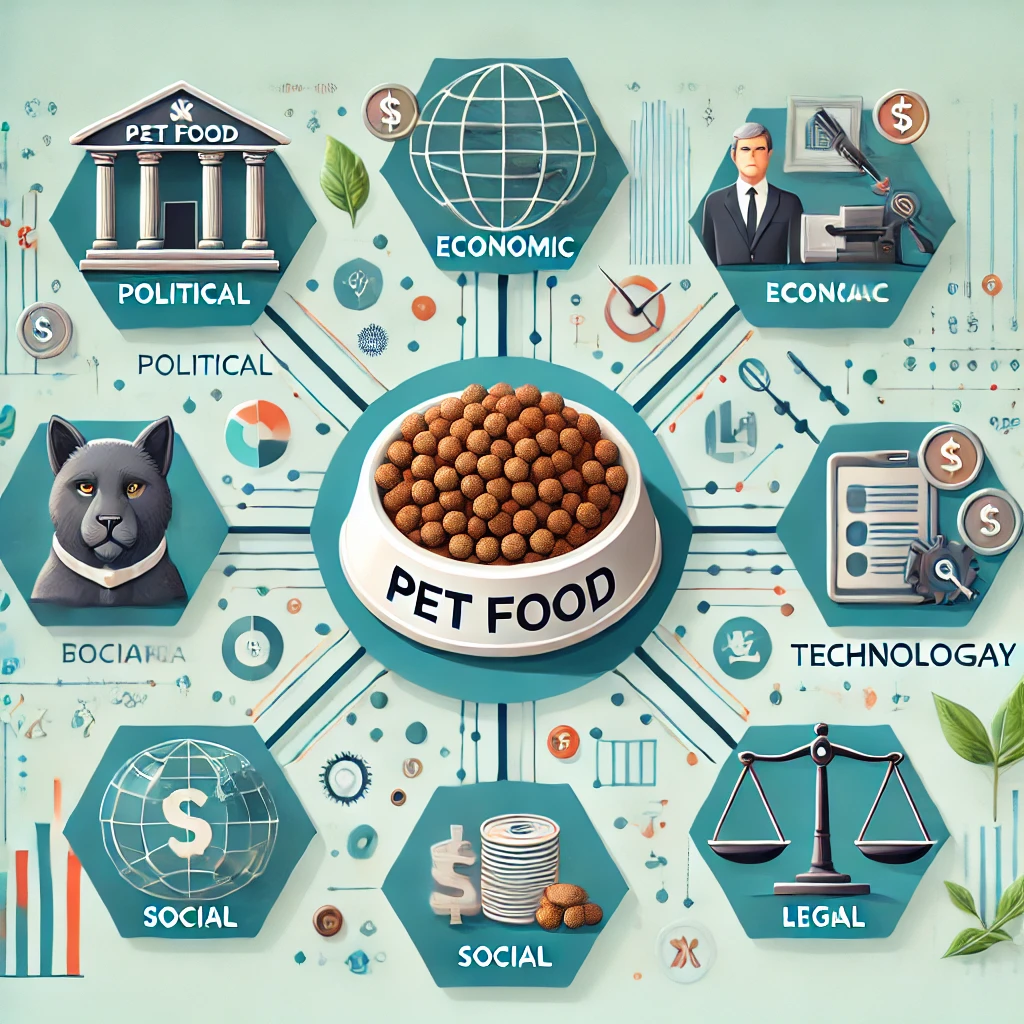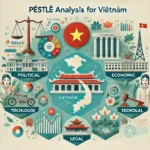The pet food industry is a dynamic and rapidly growing sector, influenced by various macro-environmental factors that impact its development and performance. A PESTLE analysis—focusing on Political, Economic, Social, Technological, Legal, and Environmental factors—offers valuable insights into the external forces shaping the industry. This analysis helps businesses and stakeholders understand the broader context in which the pet food market operates, from government regulations and economic conditions to evolving consumer preferences, technological innovations, and environmental sustainability concerns. By examining these factors, companies can better navigate challenges and seize opportunities for growth in this competitive and ever-evolving market.
Table of Contents
TogglePolitical Factors Affecting the Pet Food Industry:
1. Regulations and Food Safety Standards
Government regulations on food safety significantly influence the pet food industry. Authorities like the U.S. Food and Drug Administration (FDA) and the European Food Safety Authority (EFSA) set stringent guidelines for the ingredients used in pet foods, manufacturing processes, and product labeling. Compliance with these standards is crucial to ensure the safety of pets and avoid recalls, which can harm a company’s reputation.
2. Animal Welfare and Ethical Standards
Political decisions regarding animal welfare laws can impact the ingredients used in pet food. Governments worldwide are enacting stricter regulations on how animals are treated within the food production process, driving demand for ethically sourced and cruelty-free ingredients. This shift can affect product formulations, supply chains, and marketing strategies for pet food companies.
3. Trade Policies and Import/Export Regulations
Trade policies, tariffs, and import/export regulations directly affect the availability and cost of raw materials, such as meat, grains, and other essential ingredients used in pet food. Political tensions between countries or changes in international trade agreements can disrupt supply chains, influence pricing, and create challenges for companies that rely on global sourcing for ingredients.
4. Government Incentives and Subsidies
Government policies that incentivize sustainable farming practices or support eco-friendly production methods are increasingly influencing the pet food industry. Political initiatives that offer subsidies or tax breaks for using organic or sustainably sourced ingredients are encouraging companies to adopt greener production practices and appeal to environmentally-conscious consumers.
5. Political Stability
Political stability in key markets can impact the operational efficiency of pet food companies. Instability or changes in government leadership may lead to shifts in regulatory frameworks, economic uncertainty, or disrupted supply chains. For businesses operating across multiple countries, it is essential to monitor the political climate to assess risks and adjust strategies accordingly.
6. Consumer Protection Laws
Governments also enforce consumer protection laws that affect how pet food products are marketed and sold. These laws ensure that companies provide accurate product information and are transparent about ingredients and sourcing practices. Stricter consumer protection regulations can lead to increased scrutiny on advertising practices, labeling accuracy, and claims made about product benefits.
Economic Factors Affecting the Pet Food Industry:
The pet food industry is influenced by several economic factors. Here are some key ones:
-
Income Levels: Disposable income plays a major role in pet owners’ ability to spend on premium or specialized pet foods. In periods of economic growth, people are more likely to spend on high-quality or niche products, while in a recession, they may opt for more affordable brands.
-
Inflation: Inflation can lead to increased prices for raw materials used in pet food production, such as meat, grains, and packaging materials. Higher costs may be passed on to consumers, affecting demand for premium products.
-
Consumer Preferences: Economic conditions can influence consumer preferences. For example, during tough economic times, there may be a shift toward budget-friendly or generic pet food brands, while in times of prosperity, consumers may opt for organic, natural, or specialized pet foods.
-
Pet Ownership Trends: Changes in pet ownership, driven by economic factors, can also influence the pet food market. Economic downturns can result in fewer people adopting pets due to financial constraints, while economic growth could lead to an increase in pet adoption and, consequently, higher demand for pet food.
-
Raw Material Costs: Global commodity prices for ingredients like meat, fish, vegetables, and grains directly impact the cost of producing pet food. Events like droughts, trade disputes, or disruptions in supply chains (such as pandemics) can cause price hikes.
-
Retailer Strategies: Economic conditions influence retailer pricing strategies and promotional activities. Pet food retailers may adjust prices, offer discounts, or introduce loyalty programs to retain customers during economically challenging times.
-
Global Economic Trends: The global economy can affect trade and the availability of certain ingredients for pet food. For example, trade tariffs or international supply chain issues can disrupt the flow of materials, influencing prices and availability of pet food.
-
Health and Wellness Trends: Economic prosperity often correlates with a higher awareness of health and wellness. Pet owners may be willing to invest more in premium, organic, and specialized foods for their pets, especially as they become more conscious of the quality of ingredients and their pets’ health.
These factors combined create a dynamic environment for the pet food industry, requiring businesses to be adaptable in response to changing economic conditions.
Social Factors Affecting the Pet Food Industry:
Social factors also play a significant role in shaping the pet food industry. Here are some of the key social influences:
-
Pet Humanization: Many pet owners view their pets as family members and are willing to spend more on high-quality food, treats, and specialized diets. This trend has led to the demand for premium, natural, and organic pet foods, as well as products that cater to specific health needs (like grain-free, gluten-free, or allergen-free options).
-
Changing Demographics: Shifts in demographics, such as the increase in single-person households, can lead to higher pet ownership. People in these households often invest more in their pets, including their nutrition. Additionally, younger generations (Millennials and Gen Z) are more likely to treat pets as family and seek out premium products, fueling demand for higher-end pet foods.
-
Health and Wellness Trends: As more people become health-conscious, there’s an increasing focus on the health and well-being of pets. Pet owners are more likely to choose foods that promote health benefits such as weight management, joint support, and digestion. The demand for natural, organic, and non-GMO pet foods has grown in line with broader trends in human health and wellness.
-
Sustainability and Ethical Concerns: Consumers are increasingly concerned with sustainability, ethical sourcing, and animal welfare. This has led to a rise in demand for eco-friendly pet food packaging, as well as sustainably sourced ingredients, such as plant-based protein alternatives and ethically-raised meat.
-
Rise in Pet Adoption: Social changes, such as increased pet adoption rates (especially during the COVID-19 pandemic), have boosted demand for pet food. Pets are seen as companions and emotional support, which further drives spending on their care, including food.
-
Cultural Shifts: Cultural attitudes toward pets can influence the types of pet food products that are popular. In some cultures, pets are often fed human food, which can affect demand for conventional pet food. Conversely, in regions where pets are viewed primarily as working animals, the demand for specialized pet foods may be lower.
-
Education and Information Access: With more information available about pet care and nutrition, pet owners are becoming more educated about the importance of a balanced diet for their pets. This awareness drives demand for healthier and higher-quality food options, as well as products that cater to specific health issues like allergies or sensitivities.
-
Social Media Influence: Social media has made it easier for pet owners to share experiences, reviews, and advice about pet care, including food choices. Influencers and pet food brands are increasingly using platforms like Instagram, TikTok, and YouTube to promote pet food products, which shapes consumer preferences and trends.
-
Animal Health Awareness: As veterinary care becomes more advanced and widely accessible, pet owners are increasingly aware of how nutrition plays a critical role in their pets’ overall health. Pet owners are more likely to invest in high-quality food that caters to specific health needs, such as digestion issues or aging-related conditions.
These social factors help shape consumer behavior and preferences, influencing product development, marketing, and overall market trends within the pet food industry.
Technology Factors Affecting the Pet Food Industry:
Technology has a significant impact on the pet food industry in various ways, ranging from production to marketing and customer engagement. Here are some key technological factors affecting the industry:
-
Advancements in Pet Food Manufacturing: Modern technologies in food processing, such as extrusion and freeze-drying, have improved the quality, texture, and shelf life of pet foods. These processes allow for better nutrient retention, and the ability to create specialized products such as high-protein, grain-free, or organic pet foods.
-
Innovation in Pet Food Ingredients: Technology is enabling the development of new and alternative ingredients for pet food. Innovations such as lab-grown meat, insect protein, plant-based proteins, and other sustainable ingredients are gaining traction. This allows brands to cater to consumers looking for more eco-friendly and ethically sourced pet food options.
-
Customization and Personalization: Advancements in data analytics and artificial intelligence (AI) allow companies to offer more personalized pet food solutions. Some brands now use customer data to create tailored pet food formulations based on specific pet health needs, age, breed, and dietary preferences. AI is also being used to develop new recipes that are nutritionally balanced for individual pets.
-
Smart Pet Products: The rise of the Internet of Things (IoT) has led to the development of smart pet products, such as automatic feeders and pet food dispensers that can be controlled remotely. These devices can monitor pets’ eating habits and send data to owners, providing insights into feeding schedules, portion control, and even health metrics.
-
E-commerce and Online Sales: Technology has dramatically changed the way pet food is sold. E-commerce platforms and subscription services have made it easier for consumers to purchase pet food online, often with the option for auto-delivery. Many pet food brands are also using data analytics to personalize recommendations and optimize online sales strategies.
-
Sustainability through Technology: Technology is driving sustainability in pet food production. Companies are increasingly using innovations to reduce energy consumption, minimize waste, and create more environmentally friendly packaging. For example, some brands are adopting biodegradable packaging or using recycled materials, and technology is also being employed to develop more efficient production methods that reduce carbon footprints.
-
Blockchain for Transparency: Blockchain technology is being utilized by some pet food companies to ensure transparency and traceability in the supply chain. This technology allows consumers to track the origins of ingredients, providing reassurance about the quality and ethical sourcing of pet food.
-
Veterinary Technology Integration: Advances in veterinary technology and diagnostics are influencing pet food development. As veterinary science continues to improve, there is a growing focus on formulating pet foods that address specific health conditions such as obesity, diabetes, and allergies. Pet food companies are increasingly working with veterinarians to create specialized, science-backed products.
-
Social Media and Digital Marketing: Social media platforms and digital marketing strategies allow pet food brands to engage directly with consumers, promoting their products through targeted ads, influencer partnerships, and user-generated content. Technologies like augmented reality (AR) and virtual reality (VR) are also being experimented with to create interactive and immersive brand experiences for pet owners.
-
Data-Driven Decision Making: The pet food industry is benefiting from big data and predictive analytics to identify consumer trends, optimize supply chains, and forecast demand. This helps companies make better decisions about inventory, pricing, and product development, improving efficiency and profitability.
-
Health Monitoring Technology: Wearable technology for pets, such as activity trackers or smart collars, is becoming more common. These devices can track pets’ health metrics, such as exercise levels, sleep patterns, and even caloric burn, providing pet owners with valuable data that can inform their choices about diet and nutrition.
These technological advancements not only enhance the pet food industry’s ability to create better products but also improve consumer experience and foster new opportunities for growth.
Legal Factors Affecting the Pet Food Industry:
Legal factors play a significant role in shaping the pet food industry, affecting everything from product formulation to marketing and distribution. Here are some key legal factors:
1. Regulatory Compliance
- FDA Regulations (U.S.): The Food and Drug Administration (FDA) regulates pet food under the Federal Food, Drug, and Cosmetic Act (FD&C Act), ensuring safety and labeling accuracy.
- AAFCO Guidelines: The Association of American Feed Control Officials (AAFCO) sets nutritional standards and labeling guidelines for pet food.
- EU Regulations: In Europe, the European Pet Food Industry Federation (FEDIAF) and the European Commission regulate pet food safety and composition.
2. Labeling & Advertising Laws
- Manufacturers must comply with truth-in-advertising laws, ensuring that claims about nutrition, ingredients, or benefits are accurate.
- Misleading claims (e.g., “all-natural” or “grain-free”) can lead to legal disputes and penalties.
3. Ingredient Restrictions & Safety Standards
- Some ingredients are banned or restricted in different regions.
- Laws require pet food companies to ensure their products are free from contaminants, including bacteria, pesticides, and toxic substances.
4. Import & Export Regulations
- International trade laws impact the import and export of pet food, requiring compliance with various health and safety standards.
- Tariffs and trade agreements influence pricing and availability.
5. Recalls & Liability Laws
- Companies must adhere to recall procedures in case of contamination or safety concerns.
- Legal liabilities arise if pets suffer harm due to contaminated or misrepresented products.
6. Sustainability & Ethical Sourcing Laws
- Increasing legal pressure to ensure sustainable sourcing of ingredients and environmentally friendly packaging.
- Some jurisdictions require transparency regarding sourcing and environmental impact.
7. Animal Welfare Laws
- Regulations ensure ethical treatment of animals used in pet food production, including livestock welfare and testing restrictions.
These legal factors influence how companies operate, innovate, and market pet food products while ensuring consumer trust and compliance.
Envirnomental Factors Affecting the Pet Food Industry:
Environmental factors play a crucial role in shaping the pet food industry, influencing sourcing, production, packaging, and distribution. Here are the key environmental factors affecting the industry:
1. Sustainability of Ingredients
- Increasing demand for sustainable and ethically sourced ingredients, such as plant-based proteins and insect-based alternatives.
- Overfishing and deforestation concerns affect ingredient sourcing (e.g., fish meal and palm oil).
2. Carbon Footprint & Greenhouse Gas Emissions
- Pet food production, especially meat-based diets, contributes to carbon emissions and resource depletion.
- Companies are under pressure to reduce their carbon footprint through sustainable farming and production practices.
3. Waste Management & Packaging
- Growing concerns about plastic waste from pet food packaging.
- Shift towards biodegradable, recyclable, and minimal packaging to reduce environmental impact.
4. Water Usage & Conservation
- Pet food manufacturing requires significant water resources, from farming raw materials to processing.
- Droughts and water scarcity in key agricultural regions impact ingredient supply and costs.
5. Biodiversity & Ethical Sourcing
- Demand for pet food ingredients affects ecosystems, including soil degradation, habitat destruction, and loss of biodiversity.
- Ethical concerns over factory farming and fishing practices.
6. Regulations & Environmental Policies
- Governments and international organizations impose stricter environmental regulations on food production and waste disposal.
- Companies must comply with sustainability reporting and environmental impact assessments.
7. Climate Change Impact on Supply Chains
- Extreme weather events, such as hurricanes, droughts, and floods, disrupt ingredient supply chains.
- Price volatility due to changing agricultural conditions and reduced crop yields.
8. Consumer Demand for Eco-Friendly Products
- Increasing preference for sustainable pet food brands that use organic, non-GMO, and locally sourced ingredients.
- Growth of plant-based and alternative protein pet foods as a response to environmental concerns.
9. Energy Consumption in Manufacturing
- High energy usage in pet food processing and transportation.
- Shift towards renewable energy sources and energy-efficient production methods.
Companies in the pet food industry must adapt to these environmental challenges by embracing sustainability, reducing waste, and adopting eco-friendly production practices to meet consumer expectations and regulatory requirements.
Conclusion:
The pet food industry is significantly influenced by environmental factors, requiring companies to adopt sustainable practices to minimize their ecological footprint. Issues such as ingredient sustainability, carbon emissions, waste management, and climate change impact supply chains, production processes, and consumer preferences.
To stay competitive and compliant, pet food manufacturers must invest in eco-friendly packaging, ethical sourcing, water conservation, and energy-efficient production. Additionally, the shift towards alternative proteins and plant-based pet foods reflects growing environmental awareness among consumers.
Ultimately, embracing sustainable innovations and adhering to environmental regulations will be key to ensuring long-term growth and resilience in the pet food industry.


